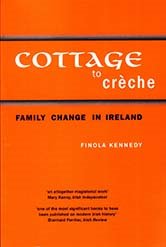 Cottage to Creche: Family change in Ireland in the twentieth century is reflected in changes in the lives of men, women and children. A typical girl born in a rural cottage in the early 1900s worked on the family homestead from childhood and left school at twelve years of age. If she married, she would have a large family; there was a strong possibility she would emigrate. By the time the first cohort of free post-primary beneficiaries left school in the 1970s Ireland had joined the EEC. As employment opportunities increased, more mothers remained in employment and more children were cared for in creches. Fewer men were sole breadwinners. Changes in the pattern of behaviour similar to those in other European countries suggested the dominance of economic factors over tradition and religion.
Cottage to Creche: Family change in Ireland in the twentieth century is reflected in changes in the lives of men, women and children. A typical girl born in a rural cottage in the early 1900s worked on the family homestead from childhood and left school at twelve years of age. If she married, she would have a large family; there was a strong possibility she would emigrate. By the time the first cohort of free post-primary beneficiaries left school in the 1970s Ireland had joined the EEC. As employment opportunities increased, more mothers remained in employment and more children were cared for in creches. Fewer men were sole breadwinners. Changes in the pattern of behaviour similar to those in other European countries suggested the dominance of economic factors over tradition and religion.
A social revolution occurred within an economic revolution. Cottage to Creche examines some of the catalysts that have led to this revolution. It looks at various dimensions of family life - marriage, emigration, birth and fertility, maternal mortality, infant mortality, abortion, adoption. It deals with the living standards of families, the roles of men and women, the role and status of children, Catholic social thought and the family and family and government.